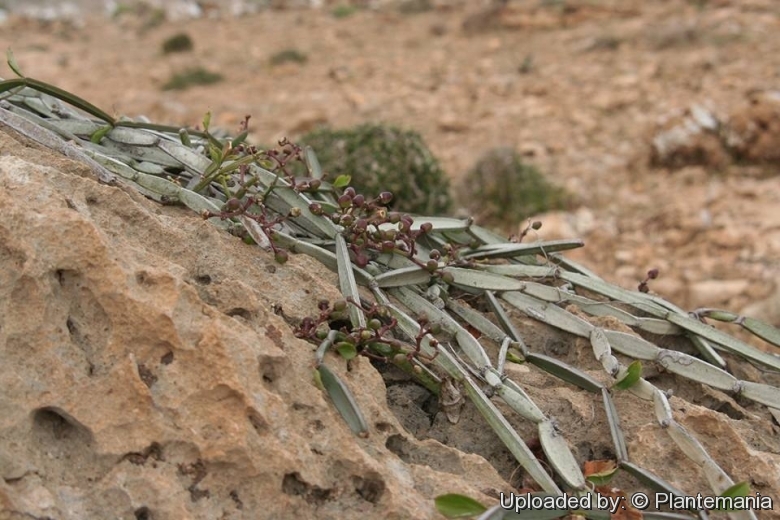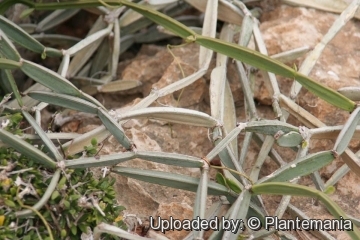




Your support is critical to our success.

Origin and Habitat: Cissus hamaderohensis is endemic to Soqotra. It replaces Cissus subaphylla above 300 m over most of the island; absent from the granite of the Haggeher. Type Hamaderoh, 12°35' N., 54°17' E.
Altitude range: 300–800 metres above sea level.
Habitat and Ecology: Sprawls in the plains vegetation on the limestone plateaus and above 300 m on lower lime-stone slopes in dwarf shrubland and open woodland together with many succulent shrubs, including Dracaena cinnabariSN|32990]]SN|32990]], Boswellia elongataSN|33360]]SN|33360]], Aloe perryiSN|23896]]SN|23896]], Jatropha unicostataSN|22492]]SN|22492]], Cissus subaphylla, Caralluma socotranaSN|27557]]SN|27557]], and many Euphorbia species. Common in several vegetation types and under no present or perceived threat. The vegetation of the lowlands and plains has been heavily impacted by overgrazing from goats and sheep.
Synonyms:
- Cissus hamaderohensis Radcl.-Sm.
ENGLISH: Tapeworm Grape
Description: Cissus hamaderohensis is a strange looking perennial, succulent, shrublets with thick slate green flattened tapeworm stems of long-spaced joints. The plant is almost leafless and the stems sprawl like snakes on the ground and among the rocks or occasionally climb by means of tendrils on surrounding vegetation.
Stems; Decumbent or climbing, entirely glabrous, very flattened, rectangular in cross-section, 7-9(-15) cm long, 1-1.5 cm wide, 3-5 mm thick, constricted at the nodes, with a base that becomes very woody with age, grey-green, glaucous, with reddish-brown angles. Tendrils are present at the nodes, simple and diametrically opposed to the leaf.
Leaves: Very short lived, deciduous, sessile or petiolate, petiole 3 - 5 mm, obovate-elliptic, spatulate, rarely tri-lobed to 12-22(-25) mm long by about 6-10(-12) mm wide, tip subacute to obtuse, narrowing at base, margins subentire. Rib not prominent.
Flowers: In lateral umbels of 6-14 flowers up to 5 cm long. Flowers are very small (± 3 mm across) and inconspicuous, greenish yellow. Calyx shaped like a flask, sub-truncate, very short or or 4-thoothed. Petals 4, oblong, fused to form a protective cap or hood, soon falling. Stamens 4, 1-5 mm long; anthers facing inward, attached dorsally to the filament, 2-locular. Disc 4-lobed, hiding the ovary. Style conical.
Blooming: Mid winter.
Fruit: Berry, ovoid, c. 8 mm, glabrous, at first green, red to black-purple when ripe.
Similar species: C. hamaderohensis resembles Cissus subaphylla but its segments are compressed-rectangular in transverse section, not elliptical, and the plant are trailing not erect. The fully functional tendrils and the conical styles distinguishes C. hamaderohensis from other Socotran species.
Bibliography: Major references and further lectures
1) Gary Brown, Bruno Mies “Vegetation Ecology of Socotra” Springer Science & Business Media, 22 mag 2012
2) Ahmad Hegazy, Jonathan Lovett-Doust “Plant Ecology in the Middle East” Oxford University Press, 14 January 2016
3) Dr. Abdul Wali Ahmed Al Khulaidi “FLORA OF YEMEN” 2013
4) MIller, A. 2004. Cissus hamaderohensis. The IUCN Red List of Threatened Species 2004: e.T45085A10971041. http://dx.doi.org/10.2305/IUCN.UK.2004.RLTS.T45085A10971041.en. Downloaded on 03 January 2017.
5) Cissus hamaderohensis by Alan Radcliffe-Smith in: “Hooker's Icones Plantarum” Bentham-Moxon Trustees, 1971
6) Urs Eggli “Illustrated Handbook of Succulent Plants: Dicotyledons” Springer Science & Business Media, 2002

Cissus hamaderohensis Photo by: © Plantemania
The gallery now contains thousands of pictures, however it is possible to do even more. We are, of course, seeking photos of species not yet shown in the gallery but not only that, we are also looking for better pictures than those already present. Read More...
Cultivation and Propagation: Cissus hamaderohensisSN|33497]]SN|33497]] is a good ground-hugging succulent in frost free zones and also a great container plant for full sun to partial shade.
Growth rate: It will grow best when provided with warmer temperatures, long daylight hours, adequate moisture and a rich soil. Given these conditions, this species will grow rapidly.
Exposure: Full sun to filtered light.
Soil: Give the plant a well drained, airy, growing medium which mainly consists of non organic material such us clay, pumice, lava grit, and only a little peat or leaf-mould.
Watering: Water regularly from spring to autumn. Keep the drier and cooler in winter, to induce dormancy. But others suggest to water it moderately all year round as it tends to be an opportunistic plant that tend to grow in each time of the year whenever it has enough water in fair weather and rest when temperatures are too hot or too cool and may have several or sometimes no growth cycles in a year. No water should ever be allowed to stand around the roots. But it adapts to different growing conditions from extreme heat and drought, to high moisture as it has a low rot potential.
Fertilization: The plants should be fed once a year with a balanced fertilizer suitable for succulent plants and this is done in the early fall.
Hardiness: The optimal temperature is 16-30°C (USDA Zones: 10 -12 ).
Spring: When winter ends and they begin to grow again, they will require much water and soaking the pots will no longer put the plants at risk for rot. In the spring they will grow well in partial shade and leaving them out in the rain may provide them with the water they need.
Summer: In the summer months they will tolerate heavy rain, but will be just as happy if the season is dry. They will tolerate hot weather outdoors as long as they are kept in strongly filtered light and this will encourage them to flower. They also enjoy some fertiliser. Moving the plants as they are developing buds may cause them to spontaneously abort the flowers all together.
Autumn: In the fall keep them outdoors until the night time temperatures drop below the 18°C.
Winter: Winter temperatures should never drop below 18°C (but easily tolerates 10° C) and assure plenty of light. In winter be sure to take extra precautions to keep them dry, because damp cool conditions when the plants are resting is an invitation to fungal infections, but - according to temperatures –some occasional lit watering may be useful.
Maintenance: In cultivation, these vines can be clipped to much shorter lengths to control rampant growth. This species do tend to get sort of leggy, which is particularly a problem if grown as a potted plant, and yearly pruning is often necessary to shape. Like quite small pots, repot in very later winter, early spring.
Pest and diseases:* Cissus are generally fairly easy to grow, especially if kept pest-free. They are susceptible to stem and root mealy bugs, and damage from these may well initiate fungal attack. Any time when there is a dead or dying stem in the pot it is important to remove it immediately and completely before other healthy stems can become ill too, isolate the healthy parts, dry them off, and re-root them in new compost.
Propagation: Cissus hamaderohensisSN|33497]]SN|33497]] is best propagated from cuttings in the spring. Most plants in cultivation have been propagated by this means alone. Take cuttings in late spring to summer, just take a cutting of the plant let it dry for 1 or 2 weeks and stuff it in the ground (preferably dry, loose, extremely well draining soil).
| Your Actions | |
|---|---|
| Back to Cissus index | |
| Back to Vitaceae index | |
 |
Back to Succulents Encyclopedia index |
Privacy stantement - Terms and conditions - How to cite - About us - Feedback - Donate



